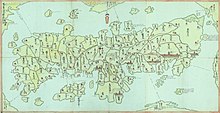Mori Domain (Izumo)
Domain of Japan (1666–1871)
• Type• Established
• Disestablished
Mori Domain (母里藩, Mori-han) was a Japanese domain of the Edo period. It was associated with Izumo Province in modern-day Shimane Prefecture.[1]
In the han system, Mori was a political and economic abstraction based on periodic cadastral surveys and projected agricultural yields.[2] In other words, the domain was defined in terms of kokudaka, not land area.[3] This was different from the feudalism of the West.
History
The domain was ruled for the entirety of its history by a branch of the Matsudaira clan of Fukui.
List of daimyōs
The hereditary daimyōs were head of the clan and head of the domain.
- Matsudaira clan, 1677–1871 (shinpan; 10,000 koku)[4]
- Takamasa[5]
- Naotaka
- Naokazu
- Naomichi
- Naoyuki
- Naokiyo
- Naokata
- Naooki
- Naoyori
- Naotoshi
See also
- List of Han
- Abolition of the han system
References

- ^ "Izumo Province" at JapaneseCastleExplorer.com; retrieved 2013-4-11.
- ^ Mass, Jeffrey P. and William B. Hauser. (1987). The Bakufu in Japanese History, p. 150.
- ^ Elison, George and Bardwell L. Smith (1987). Warlords, Artists, & Commoners: Japan in the Sixteenth Century, p. 18.
- ^ Papinot, Jacques Edmond Joseph. (1906). Dictionnaire d'histoire et de géographie du Japon; Papinot, (2003). "Matsudaira (Echizen-ke" at Nobiliare du Japon, p. 30; retrieved 2013-4-27.
- ^ Borton, Hugh. "Peasant uprisings in Japan of the Tokugawa period", Transactions of the Asiatic Society of Japan (1938), p. 46 n31.
External links
- "Mori" at Edo 300 (in Japanese)
  | This Japanese history–related article is a stub. You can help Wikipedia by expanding it. |
- v
- t
- e











